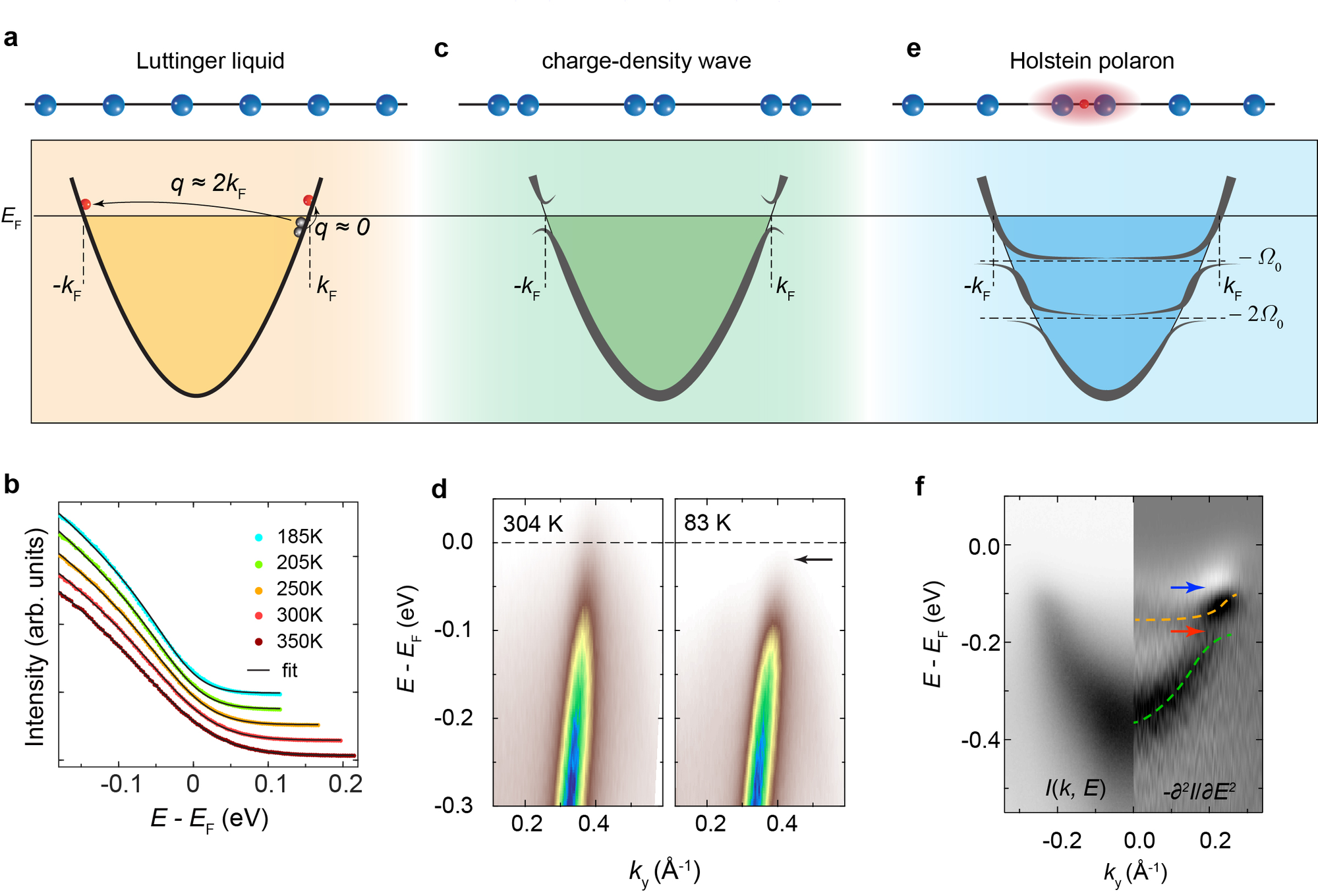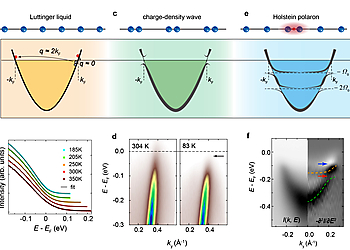Band-Selective Holstein Polaron in Luttinger Liquid Material A0.3MoO3 (A = K, Rb)
Result of the Month
In this work, we report a high-resolution laser-based ARPES study of the blue bronze A0.3MoO3 (A = K, Rb). By tracking the band dispersion over a wide temperature range, we provide spectroscopic evidence of the CDW transition near TCDW ≈ 183 K. Above TCDW, we observe a linear band dispersion with power-law scaling behavior of ARPES spectral weight, which can be precisely described by the Luttinger liquid (LL) model. Below TCDW, the LL property of the spectra revives after the CDW gap is suppressed by surface doping of Rubidium (Rb) atoms. Interestingly, we observe strong renormalizations of the band dispersions, which are identified as the spectral function of Holstein polaron derived from band-selective electron–phonon coupling (EPC) in the system. We conclude that the strong EPC in addition to the FS nesting has an important role in electronic properties and the LL-to-CDW transition in blue bronzes. Our results not only help understand the long-standing mysteries in blue bronzes, including the non-Fermi liquid behavior, the pseudogap above TCDW, and the mechanism of the CDW transition but also provide a rare platform to study the intriguing EPC in LL materials, which will also shed light on the understanding of rich physics in other Q1D materials.

Figure Description: a Luttinger liquid (LL) behavior in one dimension, where only low-energy particle-hole pairs with wave vector |q | ≈ 0 or |q | ≈ 2kF can be excited. b EDCs of Rb0.3MoO3 integrated along - with fits to finite temperature LL model (black curves). The curves are vertically offset for clarity. c Scaling plot of the EDCs at different temperatures. The scaling factor is Ta with a = 0.6. c Charge-density-wave (CDW) and periodic lattice distortion, leading to a gap opening near the Fermi energy (EF). d Comparison of the the band dispersion along the - direction measured at 304 K and 83 K. The black arrow indicates the CDW gap. e An electron dressed by the local lattice distortion, forming the Holstein polaron and leading to band gaps and flat dispersions near multiples of the phonon energy (Ω0). f ARPES intensity map of the AB band along - (left) and its second derivative (right) with respect to the energy axis measured with linear-vertically polarized 7 eV laser at 75 K. The orange and green dashed curves are the guides to eyes for the band discontinuity (emphasized with blue and red arrows).
Methods:
ARPES
High-resolution ARPES measurements were performed at beamline 13U of National Synchrotron Radiation Laboratory (NSRL), China, beamline 9 A of Hiroshima Synchrotron Radiation Center (HSRC), Japan, and Peking University, China. Data were collected with Scienta Omicron R4000 (DA30-L) electron analyzers at NSRL and HSRC (Peking University). The overall energy and angle resolutions were set to 15 meV and 0.2°, respectively.
Laser-based ARPES
Laser-based ARPES measurements were performed using DA30-L analyzers from Scienta Omicron and vacuum ultraviolet 7 eV lasers in Tsinghua University and ShanghaiTech University, China. The overall energy and angle resolutions were set to 6 meV and 0.2°, respectively.
Authors:
L. Kang, X. Du, J. S. Zhou, X. Gu, Y. J. Chen, R. Z. Xu, Q. Q. Zhang, S. C. Sun, Z. X. Yin, Y. W. Li, D. Pei, J. Zhang, R. K. Gu, Z. G. Wang, Z. K. Liu, R. Xiong, J. Shi, Y. Zhang, Y. L. Chen & L. X. Yang
Institutes:
1. State Key Laboratory of Low Dimensional Quantum Physics, Department of Physics, Tsinghua University, Beijing, 100084, China
L. Kang, X. Du, J. S. Zhou, X. Gu, Y. J. Chen, R. Z. Xu, Q. Q. Zhang, S. C. Sun, Z. X. Yin, Y. L. Chen & L. X. Yang
2. School of Physical Science and Technology, ShanghaiTech University and CAS-Shanghai Science Research Center, Shanghai, 201210, China
Y. W. Li, J. Zhang, Z. K. Liu & Y. L. Chen
3. ShanghaiTech Laboratory for Topological Physics, Shanghai, 200031, China
Y. W. Li, Z. K. Liu & Y. L. Chen
4. Department of Physics, Clarendon Laboratory, University of Oxford, Oxford, OX1 3PU, UK
D. Pei, R. K. Gu & Y. L. Chen
5. International Center for Quantum Materials, School of Physics, Peking University, Beijing, 100871, China
Z. G. Wang & Y. Zhang
6. Department of Physics, Wuhan University, Wuhan, 430072, China
R. Xiong & J. Shi
7. Frontier Science Center for Quantum Information, Beijing, 100084, China
L. X. Yang
Corresponding Authors:
Y. L. Chen or L. X. Yang
Publication: Kang, L., Du, X., Zhou, J.S. et al. Band-selective Holstein polaron in Luttinger liquid material A0.3MoO3 (A = K, Rb). Nat Commun 12, 6183 (2021). https://doi.org/10.1038/s41467-021-26078-1

